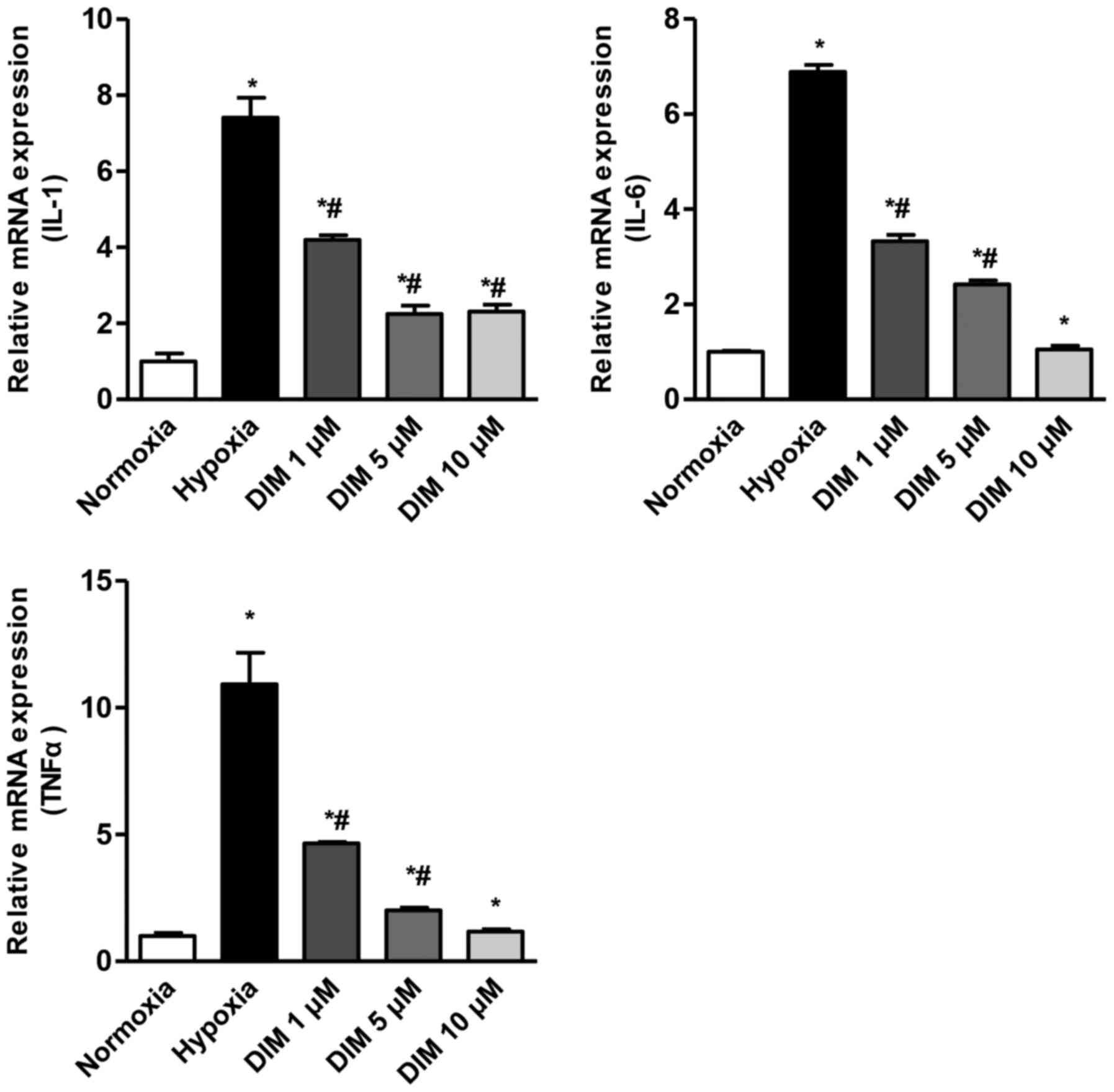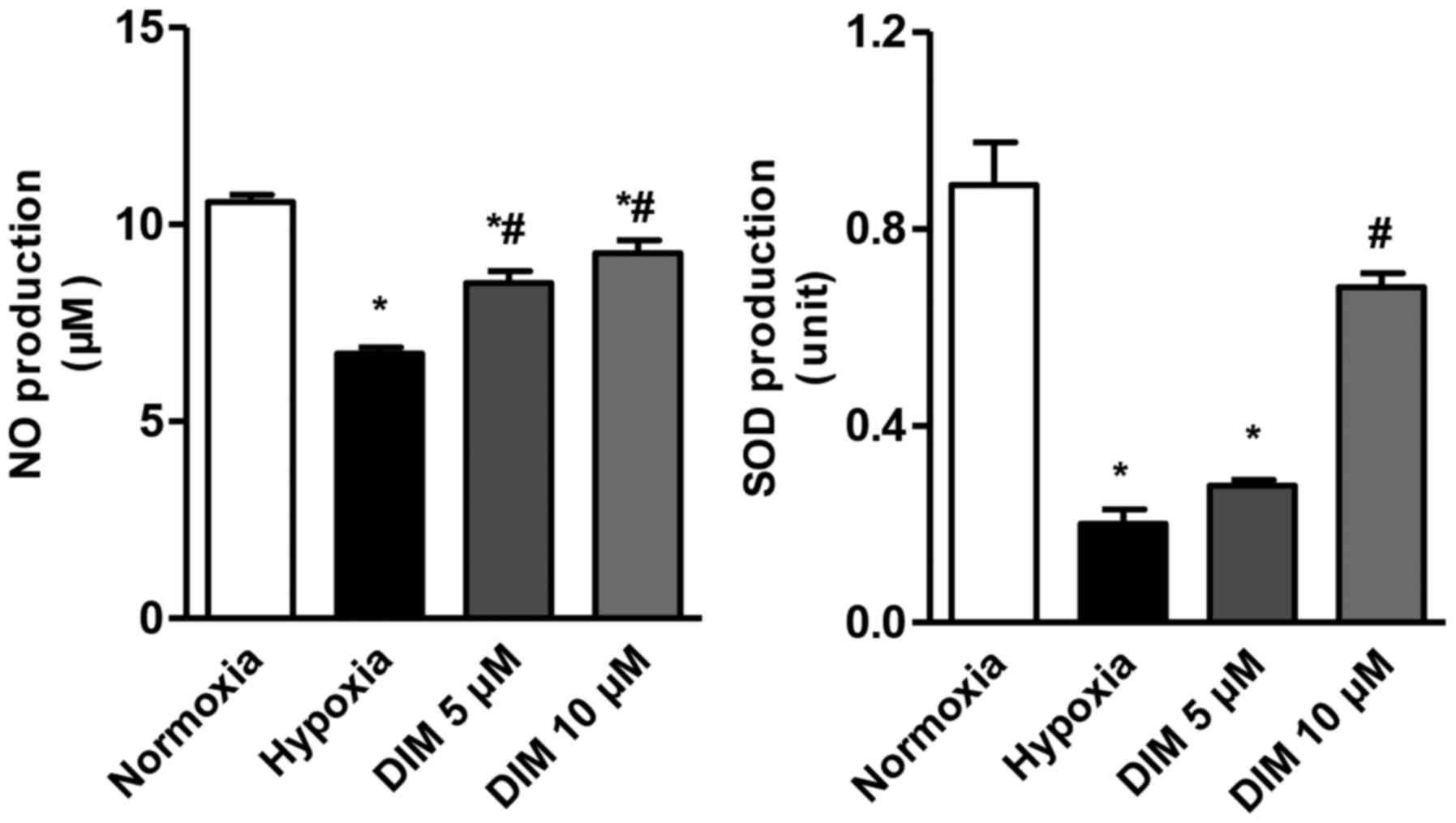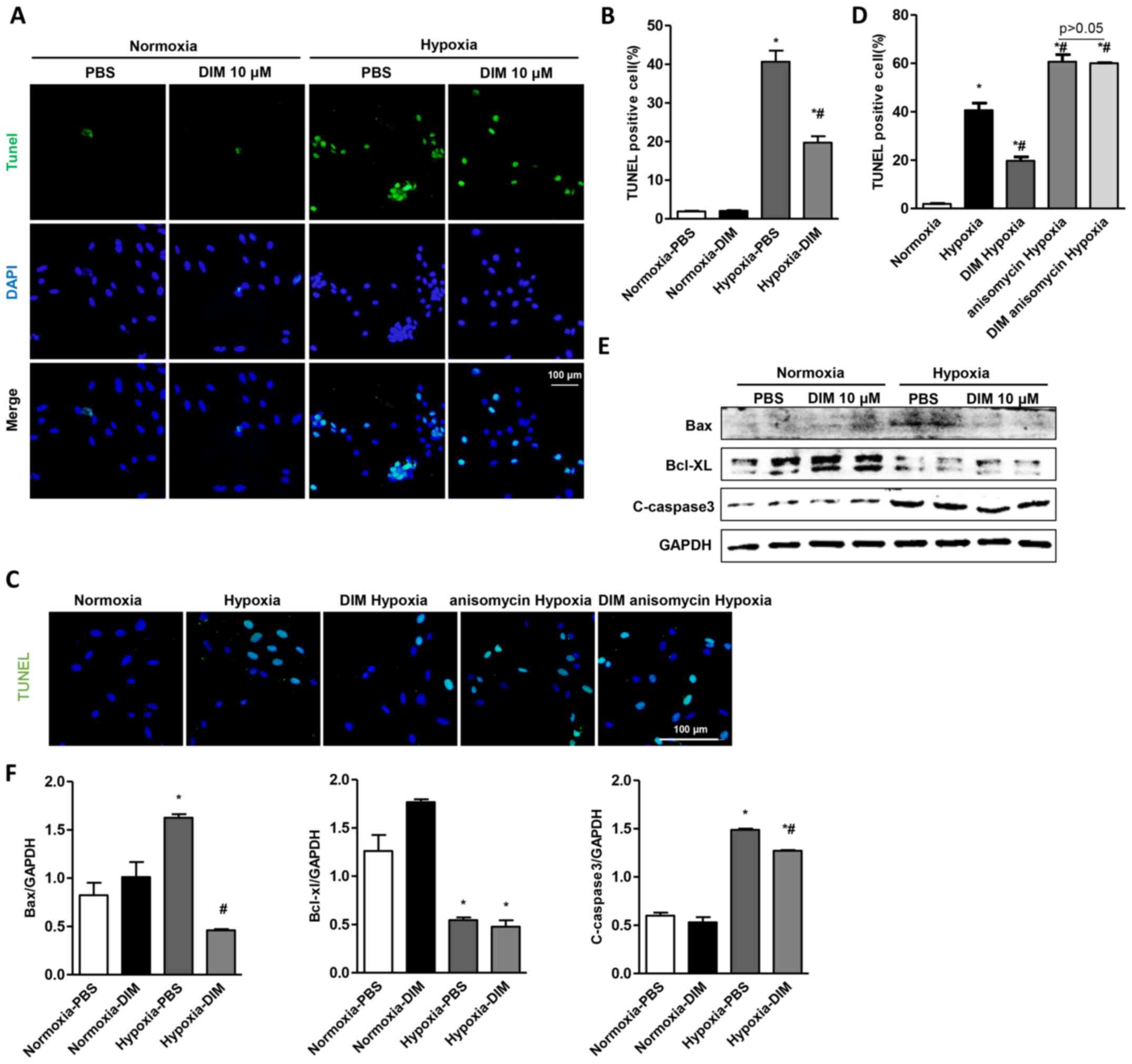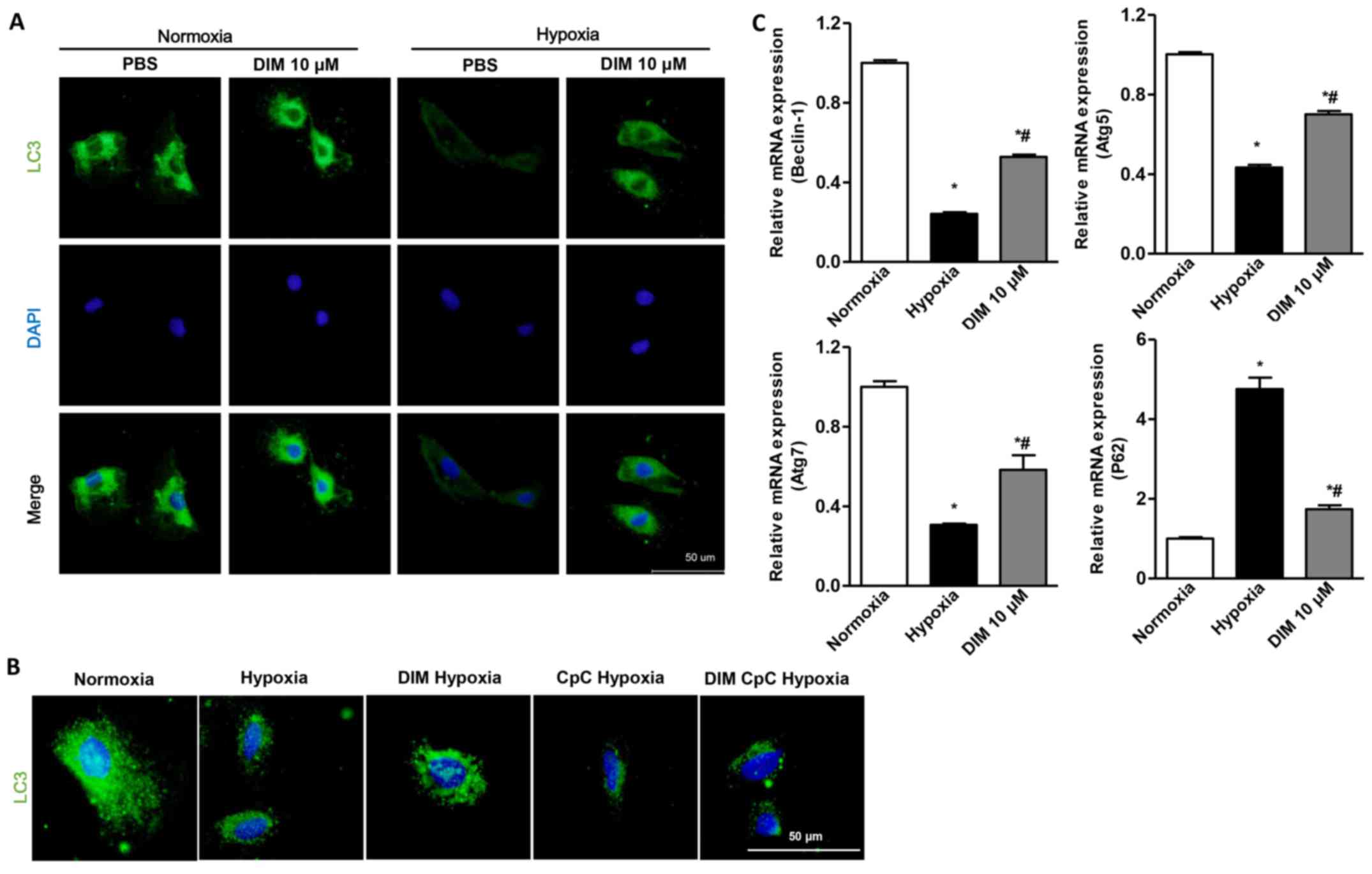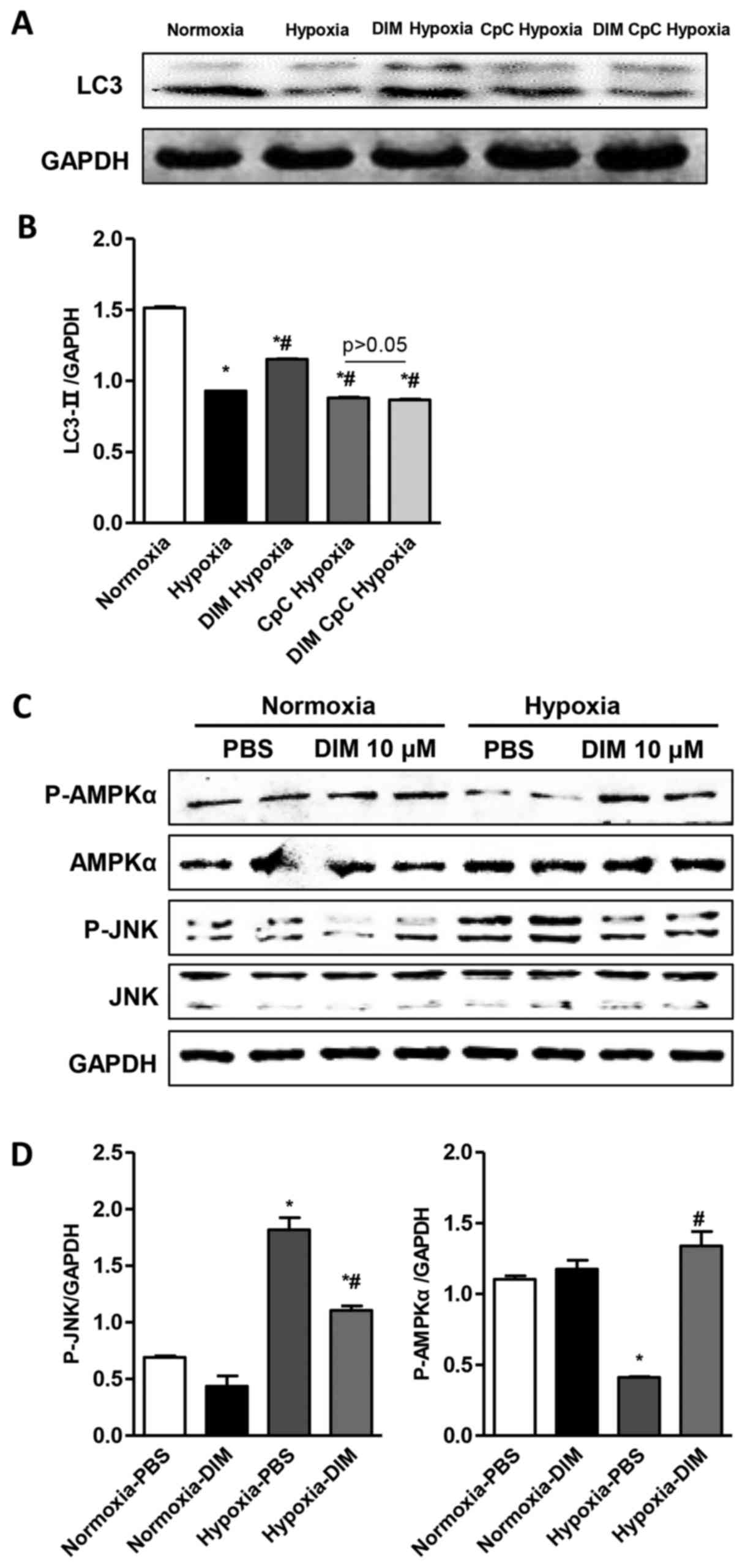|
1
|
Frangogiannis NG: Pathophysiology of
myocardial infarction. Compr Physiol. 5:1841–1875. 2015. View Article : Google Scholar : PubMed/NCBI
|
|
2
|
Levine B and Kroemer G: Autophagy in the
pathogenesis of disease. Cell. 132:27–42. 2008. View Article : Google Scholar : PubMed/NCBI
|
|
3
|
Rothermel BA and Hill JA: Myocyte
autophagy in heart disease: Friend or foe? Autophagy. 3:632–634.
2007. View Article : Google Scholar : PubMed/NCBI
|
|
4
|
Yan WJ, Dong HL and Xiong LZ: The
protective roles of autophagy in ischemic preconditioning. Acta
Pharmacol Sin. 34:636–643. 2013. View Article : Google Scholar : PubMed/NCBI
|
|
5
|
Jayakumar P, Pugalendi KV and Sankaran M:
Attenuation of hyperglycemia-mediated oxidative stress by
indole-3-carbinol and its metabolite 3,3′-diindolylmethane in
C57BL/6J mice. J Physiol Biochem. 70:525–534. 2014. View Article : Google Scholar : PubMed/NCBI
|
|
6
|
Kunimasa K, Kobayashi T, Kaji K and Ohta
T: Antiangiogenic effects of indole-3-carbinol and
3,3′-diindolylmethane are associated with their differential
regulation of ERK1/2 and Akt in tube-forming HUVEC. J Nutr.
140:1–6. 2010. View Article : Google Scholar : PubMed/NCBI
|
|
7
|
Cho HJ, Seon MR, Lee YM, Kim J, Kim JK,
Kim SG and Park JH: 3,3′-Diindolylmethane suppresses the
inflammatory response to lipopolysaccharide in murine macrophages.
J Nutr. 138:17–23. 2008.PubMed/NCBI
|
|
8
|
Azmi AS, Ahmad A, Banerjee S, Rangnekar
VM, Mohammad RM and Sarkar FH: Chemoprevention of pancreatic
cancer: Characterization of Par-4 and its modulation by 3,3′
diindolylmethane (DIM). Pharm Res. 25:2117–2124. 2008. View Article : Google Scholar : PubMed/NCBI
|
|
9
|
Chen D, Banerjee S, Cui QC, Kong D, Sarkar
FH and Dou Q: Activation of AMP-activated protein kinase by
3,3′-Diindolylmethane (DIM) is associated with human prostate
cancer cell death in vitro and in vivo. PloS One. 7:e471862012.
View Article : Google Scholar : PubMed/NCBI
|
|
10
|
Xue L, Firestone GL and Bjeldanes LF: DIM
stimulates IFNgamma gene expression in human breast cancer cells
via the specific activation of JNK and p38 pathways. Oncogene.
24:2343–2353. 2005. View Article : Google Scholar : PubMed/NCBI
|
|
11
|
Ye Y, Fang Y, Xu W, Wang Q, Zhou J and Lu
R: 3,3′-Diindolylmethane induces anti-human gastric cancer cells by
the miR-30e-ATG5 modulating autophagy. Biochem Pharmacol.
115:77–84. 2016. View Article : Google Scholar : PubMed/NCBI
|
|
12
|
Li J, Zhang W, Jiao R, Yang Z, Yuan Y, Wu
Q, Hu Z, Xiang S and Tang Q: DIM attenuates TGF-β1-induced
myofibroblast differentiation in neonatal rat cardiac fibroblasts.
Int J Clin Exp Pathol. 8:5121–5128. 2015.PubMed/NCBI
|
|
13
|
Zong J, Wu QQ, Zhou H, Zhang JY, Yuan Y,
Bian ZY, Deng W, Dai J, Li FF, Xu M, et al: 3,3′-Diindolylmethane
attenuates cardiac H9c2 cell hypertrophy through 5′-adenosine
monophosphate-activatedprotein kinase-α. Mol Med Rep. 12:1247–1252.
2015. View Article : Google Scholar : PubMed/NCBI
|
|
14
|
Deng W, Zong J, Wei L, Guo H, Cheng Z,
Zhang R, Lin Y and Tang Q: 3,3′-Diindolylmethane improves
myocardial energy metabolism imbalance induced by pressure overload
via AMPKα in mice. Int J Cardiol. 177:235–237. 2014. View Article : Google Scholar : PubMed/NCBI
|
|
15
|
Liu S, Mao J, Wang T and Fu X:
Downregulation of aquaporin-4 protects brain against hypoxia
ischemia via anti-inflammatory mechanism. Mol Neurobiol. Oct
10–2016.(Epub ahead of print).
|
|
16
|
Cheng CY: Anti-inflammatory effects of
traditional Chinese medicines against ischemic injury in in vivo
models of cerebral ischemia. Evid Based Complement Alternat Med.
2016:57394342016. View Article : Google Scholar : PubMed/NCBI
|
|
17
|
González A, Ravassa S, Beaumont J, López B
and Díez J: New targets to treat the structural remodeling of the
myocardium. J Am Coll Cardiol. 58:1833–1843. 2011. View Article : Google Scholar : PubMed/NCBI
|
|
18
|
Cuenca-López MD, Brea D, Galindo MF,
Antón-Martínez D, Sanz MJ, Agulla J, Castillo J and Jordán J:
Inflammatory response during ischaemic processes: Adhesion
molecules and immunomodulation. Rev Neurol. 51:30–40. 2010.(In
Spanish). PubMed/NCBI
|
|
19
|
Jeon EJ, Davaatseren M, Hwang JT, Park JH,
Hur HJ, Lee AS and Sung MJ: Effect of oral administration of
3,3′-diindolylmethane on dextran sodium sulfate-induced acute
colitis in mice. J Agric Food Chem. Oct 4–2016.(Epub ahead of
print). View Article : Google Scholar
|
|
20
|
Rzemieniec J, Litwa E, Wnuk A, Lason W,
Krzeptowski W and Kajta M: Selective aryl hydrocarbon receptor
modulator 3,3′-diindolylmethane impairs AhR and ARNT signaling and
protects mouse neuronal cells against hypoxia. Mol Neurobiol.
53:5591–5606. 2016. View Article : Google Scholar : PubMed/NCBI
|
|
21
|
Sun HJ, Wang Y, Hao T, Wang CY, Wang QY
and Jiang XX: Efficient GSH delivery using PAMAM-GSH into
MPP-induced PC12 cellular model for Parkinson's disease. Regen
Biomater. 3:299–307. 2016. View Article : Google Scholar : PubMed/NCBI
|
|
22
|
Rong B, Xie F, Sun T, Hao L, Lin MJ and
Zhong JQ: Nitric oxide, PKC-ε, and connexin43 are crucial for
ischemic preconditioning-induced chemical gap junction uncoupling.
Oncotarget. 7:69243–69255. 2016.PubMed/NCBI
|
|
23
|
Zhang WP, Zong QF, Gao Q, Yu Y, Gu XY,
Wang Y, Li ZH and Ge M: Effects of endomorphin-1 postconditioning
on myocardial ischemia/reperfusion injury and myocardial cell
apoptosis in a rat model. Mol Med Rep. 14:3992–3998. 2016.
View Article : Google Scholar : PubMed/NCBI
|
|
24
|
Corbalan J Jose, Vatner DE and Vatner SF:
Myocardial apoptosis in heart disease: Does the emperor have
clothes? Basic Res Cardiol. 111:312016. View Article : Google Scholar : PubMed/NCBI
|
|
25
|
Tichý A: Apoptotic machinery: The Bcl-2
family proteins in the role of inspectors and superintendents. Acta
Medica (Hradec Kralove). 49:13–18. 2006.PubMed/NCBI
|
|
26
|
Wu X, Gu W, Lu H, Liu C, Yu B, Xu H, Tang
Y, Li S, Zhou J and Shao C: Soluble receptor for advanced glycation
end product ameliorates chronic intermittent hypoxia induced renal
injury, inflammation and apoptosis via P38/JNK signaling pathways.
Oxid Med Cell Longev. 2016:10153902016. View Article : Google Scholar : PubMed/NCBI
|
|
27
|
Balakumar P and Jagadeesh G: Multifarious
molecular signaling cascades of cardiac hypertrophy: Can the muddy
waters be cleared? Pharmacol Res. 62:365–383. 2010. View Article : Google Scholar : PubMed/NCBI
|
|
28
|
Liang Q and Molkentin JD: Redefining the
roles of p38 and JNK signaling in cardiac hypertrophy: Dichotomy
between cultured myocytes and animal models. J Mol Cell Cardiol.
35:1385–1394. 2003. View Article : Google Scholar : PubMed/NCBI
|
|
29
|
Liu T, Wang G, Tao H, Yang Z, Wang Y, Meng
Z, Cao R, Xiao Y, Wang X and Zhou J: Capsaicin mediates caspases
activation and induces apoptosis through P38 and JNK MAPK pathways
in human renal carcinoma. BMC Cancer. 16:7902016. View Article : Google Scholar : PubMed/NCBI
|
|
30
|
Tien YC, Lin JY, Lai CH, Kuo CH, Lin WY,
Tsai CH, Tsai FJ, Cheng YC, Peng WH and Huang CY: Carthamus
tinctorius L. prevents LPS-induced TNFalpha signaling activation
and cell apoptosis through JNK1/2-NFkappaB pathway inhibition in
H9c2 cardiomyoblast cells. J Ethnopharmacol. 130:505–513. 2010.
View Article : Google Scholar : PubMed/NCBI
|
|
31
|
Klionsky DJ and Emr SD: Autophagy as a
regulated pathway of cellular degradation. Science. 290:1717–1721.
2000. View Article : Google Scholar : PubMed/NCBI
|
|
32
|
Costa R, Morrison A, Wang J, Manithody C,
Li J and Rezaie AR: Activated protein C modulates cardiac
metabolism and augments autophagy in the ischemic heart. J Thromb
Haemost. 10:1736–1744. 2012. View Article : Google Scholar : PubMed/NCBI
|
|
33
|
Yan L, Vatner DE, Kim SJ, Ge H, Masurekar
M, Massover WH, Yang G, Matsui Y, Sadoshima J and Vanter SF:
Autophagy in chronically ischemic myocardium. Proc Natl Acad Sci
USA. 102:pp. 13807–13812. 2005; View Article : Google Scholar : PubMed/NCBI
|
|
34
|
Hamacher-Brady A, Brady NR and Gottlieb
RA: Enhancing macroautophagy protects against ischemia/reperfusion
injury in cardiac myocytes. J Biol Chem. 281:29776–29787. 2006.
View Article : Google Scholar : PubMed/NCBI
|
|
35
|
Matsui Y, Takagi H, Qu X, Abdellatif M,
Sakoda H, Asano T, Levine B and Sadoshima J: Distinct roles of
autophagy in the heart during ischemia and reperfusion: Roles of
AMP-activated protein kinase and Beclin 1 in mediating autophagy.
Circ Res. 100:914–922. 2007. View Article : Google Scholar : PubMed/NCBI
|
|
36
|
Peng W, Liu Y, Xu WJ and Xia QH: Role of
Beclin 1-dependent autophagy in cardioprotection of ischemic
preconditioning. J Huazhong Univ Sci Technolog Med Sci. 33:51–56.
2007. View Article : Google Scholar
|
|
37
|
Li S, Liu C, Gu L, Wang L, Shang Y, Liu Q,
Wan J, Shi J, Wang F, Xu Z, et al: Autophagy protects
cardiomyocytes from the myocardial ischaemia-reperfusion injury
through the clearance of CLP36. Open Biol. 6:1601772016. View Article : Google Scholar : PubMed/NCBI
|
|
38
|
Nishida K, Kyoi S, Yamaguchi O, Sadoshima
J and Otsu K: The role of autophagy in the heart. Cell Death
Differ. 16:31–38. 2009. View Article : Google Scholar : PubMed/NCBI
|
|
39
|
Shackelford DB and Shaw RJ: The LKB1-AMPK
pathway: Metabolism and growth control in tumour suppression. Nat
Rev Cancer. 9:563–575. 2009. View
Article : Google Scholar : PubMed/NCBI
|
|
40
|
Kim J, Kundu M, Viollet B and Guan KL:
AMPK and mTOR regulate autophagy through direct phosphorylation of
Ulk1. Nat Cell Biol. 13:132–141. 2009. View
Article : Google Scholar
|
|
41
|
Kang R, Zeh HJ, Lotze MT and Tang D: The
Beclin 1 network regulates autophagy and apoptosis. Cell Death
Differ. 18:571–580. 2011. View Article : Google Scholar : PubMed/NCBI
|
|
42
|
Barth S, Glick D and Macleod KF:
Autophagy: Assays and artifacts. J Pathol. 221:117–124. 2010.
View Article : Google Scholar : PubMed/NCBI
|
|
43
|
Itakura E and Mizushima N: p62 targeting
to the autophagosome formation site requires self-oligomerization
but not LC3 binding. J Cell Biol. 192:17–27. 2011. View Article : Google Scholar : PubMed/NCBI
|
|
44
|
Liu SM, Dong YJ and Liu B: Progress of
study on p62 and protein degradation pathways. Sheng Li Xue Bao.
67:48–58. 2015.PubMed/NCBI
|



